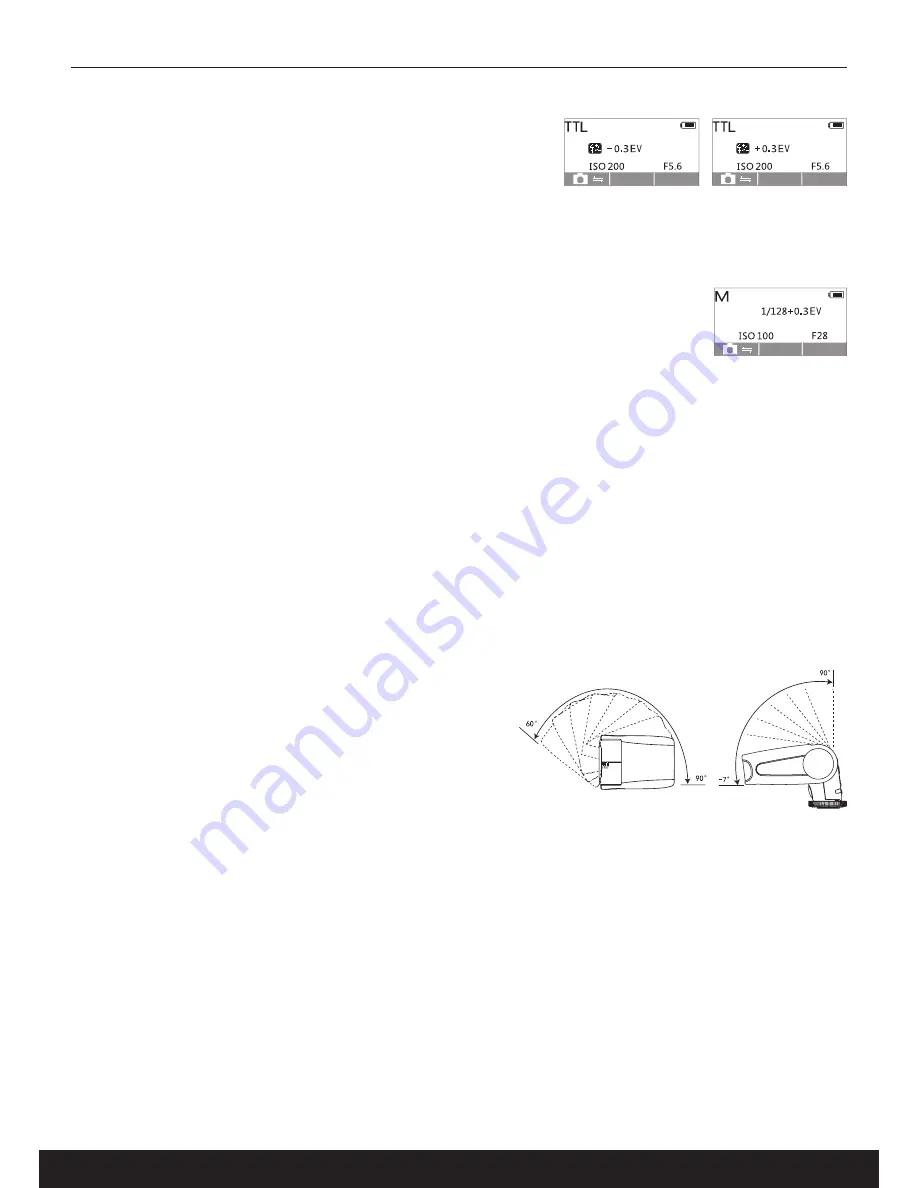
MANUAL FLASH EXPOSURE COMPENSATION WITH ETTL CONTROL (+/- CORRECTION)
The auto ETTL flash control usually ensures correct illumination. Some objects require a
more natural image effect, so the flash power needs to be slightly reduced. In other cases,
a slightly increased flash power can improve the image result. Press the C2 button to set
the desired exposure compensation value. The display shows 0.0EV. Pressing the right arrow
key, you can increase the flash power, using the left arrow key, the flash power will be reduced.
Each step corresponds to approx. 1/3EV. 1 EV corresponds to 1 aperture step. Once the desired correction figure is selected, confirm by pressing the C2
button. The correction value will be used until changed. The auto ETTL flash control remains active; however, the flash power will be influenced by the
set correction value within a range of -3.0EV to + 3.0EV.
MANUAL FLASH MODE PHOTOGRAPHY
For manual flash mode, press the MODE button until the LCD shows “M” followed by the flash power ratio.
The full flash power ratio 1/1 can be reduced down to 1/128. To set the desired flash power, press the SET button.
The flash power shows up in the LCD with a dark background and can be varied in 1/3 EV steps by pressing the
arrow keys. Aperture must be set manually. The flash range varies according to the aperture in use.
FLASH BRACKETING
When you are trying to photograph important objects in a difficult setting, bracketing with various power rations can be useful. Press the C2 button FEB.
The gradation symbol is marked in the display. Using the arrow keys, the desired gaps between the 3 bracketing shots can be set in steps of approx. 1/3
EV. Confirm with SET button.
Example: the set value is 1,3EV. The first shot will be taken with -1,3EV, the second shot without correction, the third shot will
be taken with a correction of +1,3EV.
FLASH RECYCLING TIME DISPLAY
Depending on the flash power output, it may take up to 5 seconds until the flash is ready for the next shot. During the charging time, the flash ready
indicator blinks. Once it glows permanently, the flash unit is ready to fire the next flash.
INDIRECT FLASH
The DAF-320 boasts of a bounce and tilt flash head. So the flash direction can changed horizontally by 150° (60° to the left, 90° to the right) and from -7°
to 90° vertically. You can avoid the direct flash onto your object, by directing the flash to a reflecting surface (incident angle = angle of reflection). The
surface should be neutrally white (white wall or ceiling). When using coloured reflection surfaces, the colour of the surface will be reflected with the
light, this will lead to colour distortions.
Indirect flash photography offers you the following advantages:
• Avoids harsh shadows
• Avoids red-eye effect
• Soft outlines and even illumination (particularly suitable for portraits)
• Avoids disturbing light reflections of non-metallic surfaces, e.g. glasses
Please consider that indirect flash photography reduces the flash range.
FLASH WITH DIFFUSOR
Portraits require a softer illumination. Instead of indirect flash, you can use the supplied diffusor. Mount it to the flash head front, then tilt the flash head
upwards. The flash range will be reduced with the use of the diffusor.
FLASH ON SECOND CURTAIN
Using this function, the flash will not fire when the first curtain opens, but only when the second curtain is about to close. This will affect image results
for moving objects if taken with an exposure time of > 1/30 s.
If the flash is fired onto the moving object during bulb exposure, the ambient light creates a light trail in front of the object, only the flash will fire and the
movement will be recorded. In case of flash sync on second curtain, it is the opposite. Shortly before the second curtain closes, the flash fires. Now the
light trail will follow the object and create the impression of speed and dynamic on the picture. Press the C1 button to set the second curtain flash. The
LCD shows a corresponding symbol.
Hint: Use the manual exposure mode of your camera and set the shutter speed manually. This way it will be easier to adjust to the current recording
situation. In order to avoid blurr caused by movements, we recommend the use of a DÖRR tripod.
4
GB INSTRUCTIONS FOR DÖRR DAF-320 TTL FLASH
CANON
Содержание DAF-320
Страница 1: ...DAF 320 TTL FLASH www doerrfoto de CANON...

























